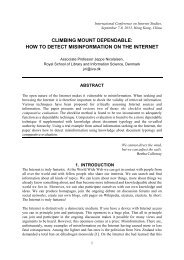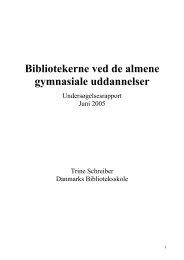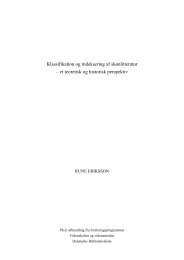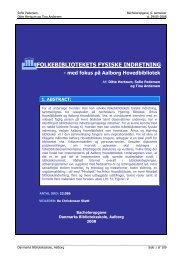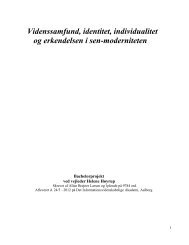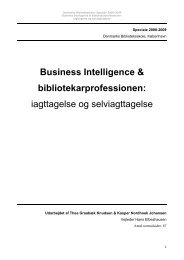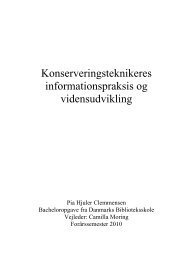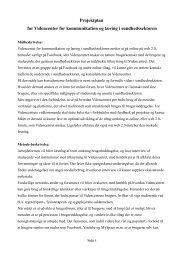Hvorfor er det sjovt at surfe på nettet? - Forskning
Hvorfor er det sjovt at surfe på nettet? - Forskning
Hvorfor er det sjovt at surfe på nettet? - Forskning
Create successful ePaper yourself
Turn your PDF publications into a flip-book with our unique Google optimized e-Paper software.
75<br />
Und<strong>er</strong>holdende int<strong>er</strong>netsøgning<strong>er</strong> – S<strong>er</strong>ena Borsello<br />
Brandtzæg, P.B., Følstad, A. & Heim, J. (2003). . I: Blythe, M.A., Ov<strong>er</strong>beeke, K., Monk, A.F. &<br />
Wright, P.C. (Eds.). Funology: From usability to enjoyment (55‐65). Kluw<strong>er</strong><br />
Academic Publish<strong>er</strong>s.<br />
Brandtzæg, P.B., Heim, J. & Karahasanovic, A. (2011). Und<strong>er</strong>standing the new digital divide:<br />
A typology of Int<strong>er</strong>net us<strong>er</strong>s in Europe. Int<strong>er</strong>n<strong>at</strong>ional Journal of HumanComput<strong>er</strong><br />
Studies, 69(3), 123‐138.<br />
Bridges, E. & Florsheim, R. (2008). Hedonic and utilitarian shopping goals: The online<br />
exp<strong>er</strong>ience. Journal of Business Research, 61(4), 309‐314.<br />
Burgoon, J.K., Bonito, J.A., Bengtsson, B., Ced<strong>er</strong>b<strong>er</strong>g, C., Lundb<strong>er</strong>g, M. & Allspach, L. (2000).<br />
Int<strong>er</strong>activity in human‐comput<strong>er</strong> int<strong>er</strong>action: a study of credibility,<br />
und<strong>er</strong>standing, and influence. Comput<strong>er</strong>s in Human Behavior, 16, 553‐574.<br />
Buse, C. E. (2009). When you retire, does ev<strong>er</strong>ything become leisure? Inform<strong>at</strong>ion and<br />
communic<strong>at</strong>ion technology use and the work/leisure boundary in retirement.<br />
New Media Society 11(7), 1143‐1161.<br />
Byström, K. & Hansen, P. (2005). Conceptual framework for tasks in inform<strong>at</strong>ion studies.<br />
Journal of the Am<strong>er</strong>ican Society for Inform<strong>at</strong>ion Scinece and Technology, 56(10),<br />
1050‐1061.<br />
Calleja, G. (2010). Digital games and escapism. Games and Culture, 5(4), 335‐353.<br />
Case, D. O. (2007). Looking for inform<strong>at</strong>ion: a survey of research on inform<strong>at</strong>ion seeking,<br />
needs, and behaviour (2. udg). Elsevi<strong>er</strong>.<br />
Chen, H. (2006). Flow on the net‐<strong>det</strong>ecting Web us<strong>er</strong>s´ positive affects and their flow st<strong>at</strong>es.<br />
Comput<strong>er</strong>s in Human Behavior, 22(2), 221‐233.<br />
Chen, H. & Wingand, R.T. & Nilan, M.S. (1999). Optimal exp<strong>er</strong>ience of Web activities.<br />
Comput<strong>er</strong>s in Human Behavior, 15(5), 585‐608.<br />
Chen, H., Wigand, R.T. & Nilan, M.S. (2000). Exploring Web us<strong>er</strong>s´optimal flow exp<strong>er</strong>iences.<br />
Inform<strong>at</strong>ion Technology & People, 13(4), 263‐281.<br />
Chung, D.S. & Yoo, C.Y. (2008). Audience motiv<strong>at</strong>ions for using int<strong>er</strong>active fe<strong>at</strong>ures:<br />
Distinguishing use of diff<strong>er</strong>ent types of int<strong>er</strong>activity in an online newspap<strong>er</strong>.<br />
Mass Communic<strong>at</strong>ion and Society, 11, 375‐397.<br />
Colley, A. & Maltby, J. (2007). Impact of the Int<strong>er</strong>net on our lives: Male and female p<strong>er</strong>sonal<br />
p<strong>er</strong>spectives. Comput<strong>er</strong>s in Human Behavior, 24, 2005‐2013.<br />
Coyle, J.R. & Thorson, E. (2001). The Effects of progressive levels of int<strong>er</strong>activity and<br />
vividness in Web marketing sites. Journal of Adv<strong>er</strong>tising, 30(3), 65‐77.<br />
Dart, J. (2006). Home‐based work and leisure spaces: Settee or work‐st<strong>at</strong>ion? Leisure<br />
Studies, 25(3), 313‐328.<br />
Davis, F.D., Bagozzi, R.P. & Warshaw, P.R. (1992). Extrinsic and intrinsic motiv<strong>at</strong>ion to use<br />
comput<strong>er</strong>s in the workplace. Journal of Applied Social Psychology, 22(14), 1111‐<br />
1132.<br />
Dede, C. (2009). Imm<strong>er</strong>sive int<strong>er</strong>faces for engagement and learning. Science, 323(5910),<br />
66‐69.



